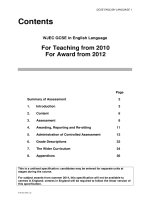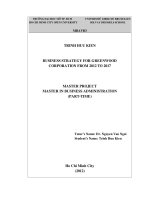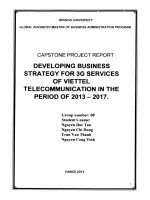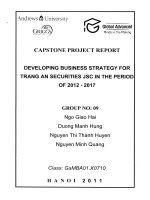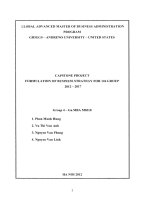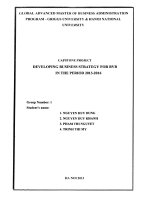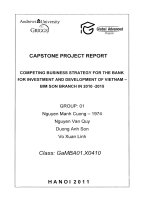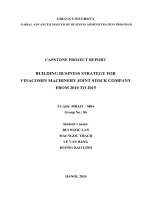Recommending business strategy for pqc from 2012 to 2016
Bạn đang xem bản rút gọn của tài liệu. Xem và tải ngay bản đầy đủ của tài liệu tại đây (2.17 MB, 82 trang )
Capstone Project Report
Page | i
Group 2- C0310
NGUYEN TUAN SON
PHAM QUYET TIEN
PHAN PHUC HAU
LAI HONG PHU
Class: GaMBA.C0310
HCM City 2012
2012 GLOBAL ADVANCED MBA PROGRAM (GaMBA01.C0310) Group No. 2
CAPSTONE PROJECT REPORT
RECOMMENDING BUSINESS
STRATEGY FOR PQC FROM
2012 TO 2016
Capstone Project Report
GLOBAL ADVANCED
MASTER OF BUSINESS ADMINISTRATION
CAPSTONE PROJECT REPORT
RECOMMENDING
BUSINESS STRATEGY OF PQC
FROM 2012 TO 2016
.
Group : 02
Members : Nguyen Tuan Son
Pham Quyet Tien
Phan Phuc Hau
Lai Hong Phu
Class: GaMBA.C0310
Ho Chi Minh City 2012
Capstone Project Report
Page | i
Group 2- C0310
ACKNOWLEGMENT
Our group would like to express our thankfulness to the Directors and the
Faculty from Center for Educational Technology and Career Development (ETC) –
Vietnam National University; ETC’s Southern Division and Griggs University for
having created us the best study conditions and have encouraged us in all the time
of research and writing this capstone.
We have further more to thank the Directors of PQC JSC as well as its
related Departments for their provided relevant information, data and their supports
for our Capstone.
We understand that due to our lack of experience and limited information,
our Capstone would have some shortcomings. However, we would really appreciate
all comments and suggestions for improvement in order to make the Capstone
become, somehow, more applicable and more meaningful to the current context of
PQC JSC.
Even though this Capstone is our first ever carried-out research, we know
that what we learn from doing the research will help us a lot not only in our
professions but also in our future academic pursuits, and we believe that all the
theoretical and practical business strategies withdrawn from this Capstone will
bring us success in our career.
WORDS OF REASSURE
We affirm that the work of this Capstone is our own research and all the
information and data used are true.
HCM City, 11
th
April 2012
Group 2 – Class GaMBAC0310
Capstone Project Report
Page | ii
Group 2- C0310
LISTS OF CONTENTS
ACKNOWLEGMENT …… … i
LISTS OF TABLES……………………………………………………………………… …………………………………………ii
LISTS OF FIGURES iii
INTRODUCTION 2
1. THE NECESSITY OF TOPIC 2
1.1 THE REASON WHY TO CHOOSE THE TOPIC 2
1.2 RESEARCH OBJECTIVES 3
1.3 OBJECT AND SCOPE OF THE RESEARCH: 3
2. RESEARCH METHODS: 3
3. TOPIC STRUCTURE: 3
CHAPTER 1 - OVERVIEW OF THE THEORY OF STRATEGIC
MANAGEMENT OF WEDDING AND CONVENTION AND THE
PRACTICAL REQUIREMENTS OF THE REPORT 4
1.1 GENERAL THEORY OF STRATEGIC MANAGEMENT OF WEDDING AND
CONVENTION 4
1.1.1 Definition of hospitality industry: 4
1.1.2 The role of strategic management: 5
1.1.3 Strategic planning process: 5
1.1.4 Classification of strategy: 5
1.1.5 The theory of service: 6
1.1.6 The tools and methods of strategic planning: 9
1.2 OVERVIEW OF THE SERVICE SECTOR OF THE PQC 12
1.2.1 Business Situation 12
1.2.2 The advantages of PQC Company 13
1.2.3 The disadvantages of PQC Company 14
1.2.4 The question for PQC Company 14
1.3 THE NECESSITY OF STRATEGIC PLANNING FOR PQC COMPANY 15
CHAPTER 2 - ANALYZING AND EVALUATING THE REAL SITUATION
OF PQC COMPANY 15
2.1 INTRODUCTION TO THE COMPANY 15
2.1.1 An overview 15
2.1.2 Business Scope - Goods and services 17
2.1.2.2) Characteristics of products & services provided 19
2.1.3 The organization structure 21
2.1.4 The current clients and partners 23
2.1.5 Business results during 3 years 2009, 2010, 2011 and plans to 2012 25
Capstone Project Report
Page | ii
Group 2- C0310
2.2 ANALYSIS OF INTERNAL ENVIRONMENT WITHIN PQC 30
2.2.1 Production 30
2.2.2 Marketing 33
2.2.3 Human resource management 33
2.2.4 Finance- Accounting 35
2.2.5 Research and development 35
2.3 THE ANALYSIS OF THE IMPACT OF THE EXTERNAL FACTORS 35
2.3.1 The analysis of macro environment of hospitality industry 35
2.3.2 The analysis of competitors 36
2.4 MATRIX OF STRATEGIC SELECTION 42
2.4.1 External Factor Evaluation matrix(EFE) 42
2.4.2 CPM Matrix 43
2.4.3 Internal Factor Evaluation matrix (IFE) 45
2.4.3 SWOT matrix 46
2.4.5 Space matrix 48
2.4.6 QSPM matrix 50
2.5 OUR GROUP GIVE GENERAL COMMENT ABOUT PQC COMPANY THROUGH THE
ABOVE MODEL 52
2.5.1 Organizational structure 52
2.5.2 Business operation 53
CHAPTER 3: BUSINESS DEVELOPMENT STRATEGY IN THE PERIOD
OF 2012-2016 IN PQC. 56
3.1 ORIENTATION AND FACTOR FOR SELECTION: 56
3.1.1 Orientations of industry development 56
3.1.2 Foundation for selection of strategic development 59
3.2 THE OBJECTIVES OF PQC IN THE PERIOD OF 2012-2016 60
3.2.1 Non-current objective until 2016 60
3.2.2 The objectives for each year from 2012 to 2016 61
3.3 MEASURES OF STRATEGIC IMPLEMENTATION 61
3.3.1 Restructuring of strategic implementation 62
3.3.2 Implementation of strategies after restructuring: 63
3.3.2.1. Strategy of supporting industries 64
3.2.2.2. Brand strategy 66
3.3.2.3.Market development: 70
3.2.2.4. Human resource management 71
3.2.2.5.Capital development. 72
Capstone Project Report
Page | ii
Group 2- C0310
LISTS OF TABLES
Table 2.1: Sold outputs – source from the PQC 20
Table 2.2: Sales revenue – source from the PQC 21
Table 2.3: Business results – source from the PQC 21
Table 2.4: Price comparison of competitors– source from the PQC 22
Table 2.5: Price comparison of competitors– source from PQC 23
Table 2.6 : Price policies in 2012, source from the PQC 24
Table 2.7: Business targets in 2012 – source from the PQC 24
Table 2.8: the evaluation of 3 stars market – PQC source 31
Table 2.9: The evaluation of ≥ 4 star market– PQC source 32
Table 2.10: strength and weakness of opponents – PQC source 33
Table 2.11: Capacity of market supply – PQC source 35
Table 2.12: External Factor Evaluation EFE 35
Table 2.13: the analysis of CPM matrix 38
Table 2.14: The analysis of Internal Factor Evaluation matrix 39
Table 2.15: The analysis of SWOT matrix 40
Table 2.16: The analysis of Space matrix 42
Table 2.17: Matrix table of quantity strategic plan 44
Table 3.1: Business results – source from PQC 52
Capstone Project Report
Page |1
Group 2- C0310
LISTS OF FIGURES
Fig 1.1: Triangle service 06
Fig 1.2: Logo of PQC 14
Fig 2.1: Banquet – PQC source 16
Fig 2.2: Toyota banquet – PQC source 16
Fig 2.3: Outdoor events – PQC source 16
Fig 2.4: PQC’s organization structure – PQC source 17
Fig 2.5: Wedding 18
Fig 2.6: U.S National day party 19
Fig 2.7: Cultural diplomacy of French consulate – PQC source 19
Fig 2.8: Cultural diplomacy of Australia consulate – PQC source 19
Fig 2.9: Pond, L’oreal product launches – PQC source 20
Fig 2.10: The issue of style magazine 2010 – PQC source 20
Fig 2.11: Appetizers – PQC source 25
Fig 2.12: XO Beef – PQC source 25
Fig 2.13: Sichuan sea-bass – PQC source 25
Fig 3.1: Organization after restructure 74
Capstone Project Report
Page |2
Group 2- C0310
INTRODUCTION
1. The necessity of topic
1.1 The reason why to choose the topic
Banquet business services in weddings-conferences business is vibrant,
attractive and is always a profitable industry despite the crisis or the economic
difficulties. In the name of love, the wedding was conceived as event of life of
people; it is the proudest social caste of whole family with friends and relatives. So
people are willing to pay generously to organize the wedding that is the most
spectacular, most impressive and luxurious.
The conferences-weddings business, in essence, can be seen as a form of
wholesalers in the catering business, but it can be sold at high prices as it is
accompanied by the service, and may be active in ingredients, portions so the profit
rate is high. The attractiveness and high profitability will usually come with very
strong competition, which requires enterprises to constantly innovate, create and
pay fine attention to their products, their services to survive and develop.
Starting with Sinh Doi wedding restaurant and then the White Palace
convention center, Phu Quy Corporation Company (abbreviated as PQC) is one of
the pioneers business in the weddings and conferences industry that is relatively
young in Vietnam. The company PQC has built a strong brand name and is always
the first choice of partners, customers.
However, due to the level of increasingly stronger competition that not only
from rivals of professional business in conferences and weddings, such as:
Diamond Palace, Royal Gala, Callary, Grand Palace but also from the high
class hotel of wedding –conferences at the same segment with 2 brands of PQC
(White Palace convention center and Sinh Doi Restaurant) such as: Movenpick,
Park Royal, Rex, Equatorial And rivals with higher levels (Park Hyatt, Sheraton)
who join the lower segment. The other potential competitor with the ability of
managing capital and technology from foreign market will also make the position
Capstone Project Report
Page |3
Group 2- C0310
and market share of PQC in the industry threatened. Thus, PQC needs better
strategy to maintain its position and continue to grow stronger in the future.
For that reason, our group has chosen the topic " Recommending business
strategy for PQC from 2012-2016 " as a research project of our group.
We hope that the jury members, Council Capstone Project Reports of Class
and other GaMBA.C0310 classmates will support our team with suggestions,
comments to the project reports to be more persuasive and feasible.
1.2 Research objectives
Report focuses on research following issues:
• Basic theory of business strategy.
• Status of business in PQC.
• Proposing appropriate measures to establish the development strategy
of PQC.
1.3 Object and scope of the research:
Reporting research project concentrated on strategic activities for
conferences-weddings business of the PQC and proposing solutions and suggestions
in the future.
2. Research methods:
Our team uses the prediction, analysis and synthesis methods, and statistical
methods, survey methods, comparing and applying a model to analyze research.
3. Topic structure:
In addition to the index, list of abbreviations, list of tables, introduction,
conclusion, list of references, appendices, subject content is divided into three major
chapters:
Capstone Project Report
Page |4
Group 2- C0310
Chapter 1: Overview of the theory of strategic management of wedding and
convention, and the practical requirements of the report.
Chapter 2: Analysis and evaluation of the status of the activities of PQC
Company.
Chapter 3: Business Development Strategic from period 2012 to 2016 of PQC
Company.
Chapter 1 - Overview of the theory of strategic management of wedding and
convention and the practical requirements of the report
1.1 General theory of strategic management of wedding and convention
1.1.1 Definition of hospitality industry:
The “hospitality industry” consists of broad category of fields within the
service industry that includes lodging, restaurants, event planning, theme parks,
transportation, cruise line, and additional fields within the tourism industry. The
hospitality industry is a several billion dollar industry that mostly depends on the
availability of leisure time and disposable income. A hospitality unit such as a
restaurant, hotel, or even an amusement park consists of multiple groups such as
facility maintenance, direct operations (servers, housekeepers, porters, kitchen
workers, bartenders, etc.), management, marketing, and human resources.
The hospitality industry covers a wide range of organizations offering food
service and accommodation. The industry is divided into sectors according to the
skill-sets required for the work involved. Sectors include accommodation, food and
beverage, meeting and events, wedding, gaming, entertainment and recreation,
tourism services, and visitor information.
Capstone Project Report
Page |5
Group 2- C0310
Strategic Management can be defined as an art and science of establishment,
implementation and evaluation of decisions concerning many functions that allow
an organization to achieve those objectives.
1.1.2 The role of strategic management:
"A national, an organization without a strategy is like a ship without
rudder that would not know where to go".
Strategic management oriented for the development of business in the long
term, to achieve the objectives.
In internal affair of business, strategic management helps to facilitate
decision making which unify and coordinate the smooth, flexible activities.
In the business environment conditions are changing and complicating;
management strategy activities always help administrators proactively before the
changes of the environment, harnessing the opportunities, and reduce the threat.
Then the manager can propose the solutions, target to adapt with the environment.
1.1.3 Strategic planning process:
Consisting of 5 steps: Establishing the objectives, estimating current
position, setting and selecting strategies, implementing strategies, evaluating and
controlling strategy, implementing plan.
1.1.4 Classification of strategy:
According to the different approaches, that will have different strategies:
Company strategy level: integrated strategy group (front combination, rear
combination, horizontal combination; intensive strategy groups (market penetration,
market development, product development ) other strategic groups (joint venture,
mixed strategy ). Strategic business unit level: strategy of product differentiation.
Functions strategic level: marketing strategies, finance strategies, human
resource strategies.
Capstone Project Report
Page |6
Group 2- C0310
1.1.5 The theory of service:
a / Definition:
Service is a process of backstage activities and other front activities where
customers and service providers interact with each other, thereby to satisfy needs
and wants as well as create value for customers.
b / Characteristics of the service:
Service usually has specific characteristics that distinguish the different kinds of
tangible goods. Services often have the following characteristics.
b.1 - Invisibility:
The intangible nature of services is not to touch or grasp and services do not
have specifically shape as products. The experience of customer service usually
consists of a sequence of activities. Each activity represents an organization
providing services to customers. So basically the service provider is the
implementation, which it opposed to physical products of tangible capital.
b.2 - The inseparability (production and consumption at the same time):
The inseparability from the service here is talking about the difficulty of
distinguishing between a service creation and use of services as two separate jobs or
two separate processes.
A service cannot be separated into two phases: forming phase and use phase.
The creation and use of most services will occur simultaneously. Goods and
services are not the same. Goods are produced first and then put into the warehouse,
sale and use. As services are created and used throughout the process of creating
such services.
b.3 - Heterogeneity:
Heterogeneity here is the difference of the level of service performance. It
means that services can be ranked from very poor to excellent service.
Heterogeneity associated with high variability in the implementation of services.
The essential problem of a service may vary depending on the service, customers
Capstone Project Report
Page |7
Group 2- C0310
and time. Basically, variations in service also likely occur and occur more
frequently than non-conformity of organic products because of the service level
with high human interaction. This feature makes the standardized services become
more difficult.
b.4 - The nature is not stored:
The service cannot be stored and then retrieved for using. A service will
disappear if we do not use it. We cannot store services, so a service cannot be
produced or left in stock and then sold. When a service is done, not a part of the
service can be restored. To reduce the influence of unsorted service, people are
trying to sell the service at its highest level.
b.5 - Selecting the service is bound by client:
Customers and employees must close together to implement the service.
Therefore business locations must close to customers.
c - The strategy in the competitive service:
c.1 – The value models of the service:
A management philosophy of perfect service represented by triangle service.
The three corners of this triangle are: service strategy, staff and organizational
systems. The intersection point and the center of the triangle is the customer. The
heart of the triangle is the customer "know your customer" is critical to any
organization (before the customer is satisfied, the enterprise must clearly know what
their wants and needs are).
Strategy
Staff
System
Customer
Fig 1.1: Triangle service
Capstone Project Report
Page |8
Group 2- C0310
So the strategy development based on customer, this strategy focuses on
customers and lead to organizational commitment. From the knowledge of
understanding of customers, we can develop two key elements of service strategies:
(1) Concentrating on the inside-the organization's commitment to service.
(2) Concentrating on the outside-the promise of our service to customer.
c.2 - The strategy of the organization:
Common-objectives
(Level 1: Director)
Analysis of the objective
in the proposed strategy
Developing strategy and
planning of the business
strategy
Objectives
( Level 2: Strategic
Activity)
Identification-of
priority
Analyzing and strategy
setting and strategy
planning
Plan-Amendment
and strategy
The process of strategic planning “above-under”
Above – under process
Under - above process
Mission, general objectives,
constraints (facilities, resources)
Strategy and common objective
Strategic-activities
(Division, department)
Objectives, strategic, activities
(Division, department)
Capstone Project Report
Page |9
Group 2- C0310
c.3 - Models of competitive service strategy:
ADVANTAGES
COMPETITION
Low Cost
Differences in product
Competitive level
Width
The lower pricing
Differences in product
Narrow
The core expenses
The core on product
differentiation
1.1.6 The tools and methods of strategic planning:
a) Sector analysis: matrix evaluation of external factors (EFE):
- EFE Matrix was built in five steps:
Listing the elements: collect a list of external factors; divide the elements into two
groups: Opportunities and threats
Specifying a task for each element, the value of each task should be divided
between 0 and 1.0, 0 means the factor is not important. 1.0 is very important. The
total value of the task is equal to 1.0.
An evaluation for each factor, an evaluation should be divided between 1 and 4.
The rating shows how effective current strategy of the business response elements.
1 = low response, 2 = below average response, 3 = above average, 4 = high.
Multiplying each element with each assessment task, this will calculate the
recorded elements.
Plus all the tasks for each element, this will calculate the total score for business.
b) Analysis of the sector: competition picture Matrix (CPM)
Capstone Project Report
Page |10
Group 2- C0310
This matrix shows a clear picture of the strengths and weaknesses of the business
relative to the competitors in the same industry.
This matrix is an extension of the EFE Matrix task for each element, the meaning of
each task and total number of tasks.
c) Analysis of sector: matrix of inside factor evaluation (IFE)
- Matrix IEF was established by the five steps:
Listing from 10 to 20 factors, including the strengths and weaknesses affecting
the business
Classification of the importance of each factor based on a scale of 0.0 - 1.0
Identifying the importance of each factor based on the scale of 1-4
Multiplying the importance of each element with its evaluation of score
Sum of points for each factor to the total number of points on the importance
If the total importance of the matrix is less than 2.5: Enterprises with weak internal
factors and on the contrary, if the total importance of the matrix is above 2.5:
enterprises with powerful internal factors.
d) Matrix with strengths - weaknesses, opportunities - threats (SWOT)
SWOT Matrix is a tool that combines the strengths (S), weaknesses (W),
Opportunities (O) and threats (T) to make four different strategies as follows:
S
List all strengths
W
List all the weaknesses
O
List all opportunities
Combine S-O
Combine W-O
T
List all threats
Combine S-T
Combine W-T
To set the SWOT Matrix, the administrator must go through eight (8) steps:
Step 1: List all the opportunities from the external environment (O1, O2 )
Step 2: List all the major threats from the external environment (T1, T2 )
Capstone Project Report
Page |11
Group 2- C0310
Step 3: List all the strengths of the company (S1, S2 )
Step 4: List all the weaknesses of the company (W1, W2 )
Step 5: Combine the strengths and opportunities (SO)
Step 6: Combine the weakness and opportunity (WO)
Step 7: Combine the strengths and threats (ST)
Step 8: Combine Weaknesses and Threats (WT)
e) The matrix of strategic position and action evaluation (SPACE 4-
dimensional analysis)
SPACE matrix shows that business strategy should choose: Attack,
conservative, defensive, or competitive. The axes have the following meanings:
FS: The financial strength of enterprise
CA: The competitive advantage of enterprise
ES: The stability of the environment
IS: The strength of Industry to establish a SPACE matrix, we need to
perform the following steps:
Step 1: Choose a set of variables was evaluated using a competitive advantage
(CA), industry strength (IS), environmental stability (ES), and financial strength
(FS).
Step 2: Evaluate the individual elements using the evaluation system specifically
for each dimension. Assess the competitive advantage (CA) and environmental
stability (ES) using a rating scale from 6 (worst) to 1 (best). Evaluating industry
strength (IS) and financial strength (FS) using the rating scale from +1 (worst) to +6
(best).
Capstone Project Report
Page |12
Group 2- C0310
Step 3: Find the average score for competitive advantage (CA), industry strength
(IS), environmental stability (ES), and financial strength (FS).
Step 4: Draw the graph from step 3 for each dimension on SPACE matrix with the
appropriate axis.
Step 5: Add the average score for the size of competitive advantage (CA), industrial
strength (IS). That will be your last point on the axis X of SPACE matrix.
Step 6: Add the average score for SPACE matrix about the dimension of
environmental stability (ES), and financial strength (FS) to find your last point on
the axis Y.
Step 7: Find the intersection of X and Y. Draw a line from the center of the SPACE
matrix to your point. This line indicates the type of company strategy to pursue.
f) Quantifiable strategic planning matrix (QSPM)
The matrix used for rating the feasible strategic plan, so we have a platform
to choose the best strategy.
This matrix uses all the inputs from all development matrixes (EFE & IFE
Matrix, matrix picture competition, SWOT matrix, SPACE matrix). The core of the
important factors ranked from 1 to 4. 4: very important, 3 important, 2 fairly
important, 1: unimportant.
Attractions in each strategy given a rating scale from 1 to 4; 1: completely
unattractive, 2: less attractive, 3: quite attractive, 4: very attractive. A success factor
affecting the choice of strategy is no point.
1.2 Overview of the service sector of the PQC
1.2.1 Business Situation
Starting its career in 1997 as Sinh Doi restaurant for wedding party business,
and then as White Palace Center in 2007, now PQC has become a leading provider
of wedding party and convention services in Ho Chi Minh City. PQC’s main
products and services are contained in the business of wedding parties, conventions
and events (with banquets). At present, PQC has more than 1,000 well-trained
Capstone Project Report
Page |13
Group 2- C0310
employees able to serve nearly 10,000 guests per day. The annual revenue and
profit of PQC company growth sustainably and strongly. Revenues in 2010 reached
291 billion VND and a profit reached 65 billion VND. Revenues in 2011 reached
385 billion VND, profit reached 86 billion VND. Overall, wedding and conference
business is still one of the most exciting activities with the continuous project that is
built and put into exploitation from 2000 to present (De Nhat restaurant, Phong Lan,
Dong Ho, Cung Hy…) besides, the premium segment of the wedding market is a
race with new rivals such as Gala Royal, Callary, Grand Palace Diamond Palace,
Riverside Palace……
1.2.2 The advantages of PQC Company
- PQC has long-term operations in wedding party & convention business, with
famous trade mark in the field.
- White Palace provides the largest floor area of 8,000 square meters and pillar
less ballrooms in HCM city, there are two grand ballrooms of more than 3,000
square meters. It is suitable for large scale convention and event for conferences-
weddings business, the grand ballrooms can be decided into five section with
movable partition.
- The management team and staff are professionally trained.
- The results of business activities in all years are growth and sustainability.
Profits increased and accrued annually. The financial situation is explicit.
- Many multinational companies in the world of hotel-restaurant sector
concerned and questioned to cooperate together.
- The segment of potential customer strong growth including quantity and
quality. Due to mechanical and biological population increase in HCM City the
number of intellectuals and young professionals significantly increased in recent
years.
Capstone Project Report
Page |14
Group 2- C0310
- The corporation, domestic and foreign companies investing and setting up
headquarters in Ho Chi Minh City are increasing, Therefore the need of organizing
some important events is also frequently increasing .
1.2.3 The disadvantages of PQC Company
- The big-name opponents participate more deeply in the sector of providing
conference - banquet service such as Gala Royal, Callary, Grand Palace Diamond
Palace, Riverside Palace.
- In the short term, the domestic and foreign economies are difficult due to the
storm of global economic recession.
- The organizational structure is no longer suitable for the new environment
- The ground is big enough to expand the Company's business network but
currently has many limitations, the land fund for the center of Ho Chi Minh City is
exhausted.
- The quality of the training schools and the training centers for hotel
restaurants are limited, so they cannot meet the requirements of the Company.
Annually, the Company has to train dozens of former and new employees to
improve the quality customer service.
- The current food supply market meets many difficulties on food safety
issues.
- Customers are more increasingly critical in choosing the wedding and
conference events.
1.2.4 The question for PQC Company
- Restructuring the company's operations to suit the new business
environment.
- Developing the supporting industries for banquet-conference businesses: For
establishing the subsidiary to specialize in each area activities such as the
corporation of training and human resource management; providing food sources.
Capstone Project Report
Page |15
Group 2- C0310
- Looking for potential foreign partners and brand to expand business
activities.
- Expanding the network of restaurants in Ho Chi Minh City and several large
cities in the country to improve competitiveness.
1.3 The necessity of strategic planning for PQC Company
Currently, the brand and the financial ability of PQC Company are strong
enough and they can compete with any competitor in the market. Enterprise size is
more increasingly; the business areas are increasingly intense competition requiring
PQC Company to have specific and long-term business strategy. Therefore, the
strategic planning is really necessary and it demonstrates the professionalism in
business, the success or failure in the future of business depending primarily on the
business strategy of the company.
Chapter 2 - Analyzing and evaluating the real situation of PQC Company
2.1 Introduction to the company
2.1.1 An overview
• Name: Phu Quy Corporation Company
• Abbreviation: PQC
• Capital: 500 billion VND
• The main address: 194 Hoang Van Thu, Ward 9, Phu Nhuan district, HCM City.
• Logo:
Capstone Project Report
Page |16
Group 2- C0310
Fig. 1.2: logo of PQC
• Business scope: business in hospitality industry feasting specializes (wedding) and
events, conferences and workshops together with catering services.
• History of establishment and development:
Starting business with Sinh Doi wedding center in 1997 (address 120 Ly
Thai To Street, District 3, HCMC), PQC company has been very successful in
running a large and the most luxurious wedding reception center, and it is
considered as "the pioneer" in the wedding technology sector in Ho Chi Minh City.
Referring to Sinh Doi Wedding center is to mention the quality, service scale
and reputation for customer when placing the wedding here. Sinh Doi wedding
center is located in the convenient business area; its scale includes five banquet
halls with a different area. It will be arranged with the number of tables that is
suitable to customer needs. Sinh Doi’s Banquet hall were luxuriously decorated
with the suitable space observing the entire stage, sound system, lighting quality to
ensure customer's perfect wedding. Sinh Doi wedding service was designed in the
package, and varied to meet the needs of each client setting the party. Sinh Doi is
the pioneer company when putting photos of the wedding guests and family friends
after the party organization on Sinh Doi’s website.
Continuing these successes, in 2007 PQC Company expanded a new brand-
White Palace Convention Center (address: 194 Hoang Van Thu, Phu Nhuan
District, HCM City) which is a venue for holding parties , the largest conference in
the city and quickly became a successful venue for many events of large company,
the famous multinational company.
Capstone Project Report
Page |17
Group 2- C0310
Currently, there are more than 1,000 professional staff working at the PQC
and the company can serve nearly 10,000 customers a day.
• PQC company's mission: Bring to the professional management solutions and
efficiency in the hospitality industry.
2.1.2 Business Scope - Goods and services
2.1.2.1) Products and services of PQC:
- Banquet & party business:
Capstone Project Report
Page |18
Group 2- C0310
Fig. 2.1 banquet - PQC source
- Organizing high-level events, conventions, conferences, seminars, …
Fig 2.2 Toyota banquet- PQC source
- Picnic catering services
Fig 2.3 Outdoor events- - PQC source
Capstone Project Report
Page |19
Group 2- C0310
2.1.2.2) Characteristics of products & services provided
- Banquet & party catering services:
Requisites of banquet & party catering services:
Good and professional customer care (before and after the provision
of the catering services). Particularly, emphasis is put on pre-catering
care by information exploring, and exploiting upon the party
reservation by customers, for classifying their needs and then
providing them with our advice, right at the beginning.
Solemn premises and favorable location for banquet catering.
Standard sound, lighting systems and equipment.
Professional teams of cooks and managerial staff for high-quality
banquet catering.
Standard and diverse catering factors which can meet all the
customers’ needs.
Providing attendant services: MCs, receptionists, wedding ceremony
program (traditional, modern-styled, …) upon customers’ request…,
fresh flower decorations, filming, photo taking, Rolls-Royce for hire,
after-party gifts to guests, later access to party pictures via website
address, after-wedding gifts to the married couple, customer service
on wedding anniversaries …
Customers will be received heartily and thoughtfully in impressive spaces
and the professional banquet catering by PQC at its two venues of Sinh Doi and
White Palace. PQC has established a customer care procedure prior to the service
provision, whereby inquiring customers will be provided with detailed information
on party prices, catering conditions, and customer gratitude programs, when they
